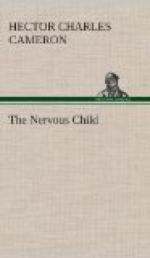Of the treatment of chorea there is no need to speak. It is purely symptomatic. Isolation, best perhaps away from home, as might be expected, gives the best results. If there are pronounced rheumatic symptoms, the salicylates will be needed; if there is anaemia, arsenic and iron; if there is sleeplessness and great restlessness, bromides or chloral. Hypnotism is often almost instantly successful, but, apart from hypnosis, curative suggestions proceeding from the attendants form the principal means at our disposal.
(4) EXHAUSTION AND KATATONIA
A large number of children, in convalescence from infective disorders, when the nutrition of the body has fallen to a low ebb, show as evidence of cerebral exhaustion a group of symptoms which in a sense are the reverse of those which characterise cerebral irritation and chorea. The healthy child is a creature of free movement. The children we are now considering will sit for a long time motionless. The expression of their faces is fixed, immobile, and melancholy. If the arm or leg is raised it will be held thus outstretched without any attempt to restore it to a more natural position of rest for minutes at a time. The posture and expression remind us at once of the katatonia which is symptomatic of dementia praecox and other stuporose and melancholiac conditions in adult life. Symptoms of this sort are especially common in children with intestinal and alimentary disturbances of great chronicity.
The symptom is so frequently met with that it is strange that it should have attracted so little attention as compared with the contrasting condition of chorea. And yet it is of more serious significance, more difficult to overcome, and with a greater danger that permanent symptoms of neurasthenia will result. In early childhood a careful dietetic regime, suitable hygienic surroundings, and a stimulating psychical atmosphere will often effect great improvement. As in chorea, however, relapses are frequent, and there are cases which for some unexplained reason are peculiarly resistant to all remedial influences.




